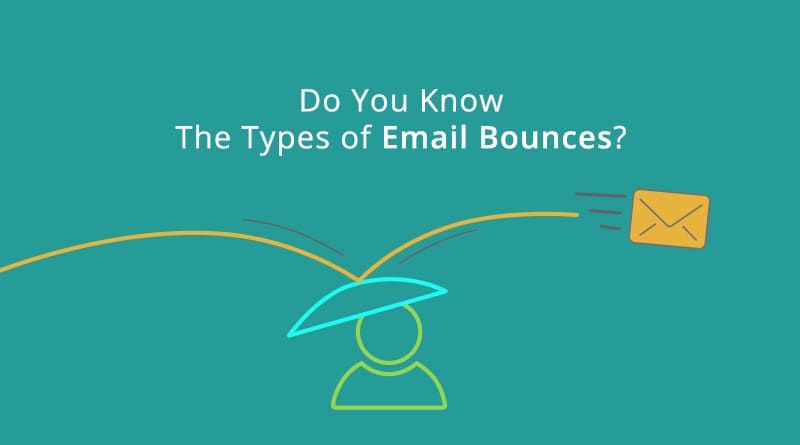Are you aware of email bounces? What is it? When a subscriber rejects email server, it is called as an email bounce. The most common reasons behind email bounces are permanent or temporary issue with the email account receiving emails or the email is blocked by the receiving server. When there is an email bounce, the recipient’s server sends back a message to the sender.
Email Status Report helps you to view the reasons and it can be accessed as here – Marketing > Reports > Email Status Report. Also, you can set up actions that activate for each type of bounce as here – Marketing > Settings > Template Settings and click on the Email Status Automation tab. These actions can be utilized to differentiate people based on bounce issues and/or follow up with individuals for requesting a new email address or resolving the issue that prevents email delivery.
Let’s understand the different types of email bounces.
Types of Email Bounces
General Bounce
When the server can’t deliver an email message, but also can’t detect a specific reason, it is a general bounce. Several times it is related to soft bounce as the exact reason behind the delivery failure can’t be determined. The technical issue such as “Connection timed out” is one of the associated issues with this type of bounce. Additionally, a bounce is classified as “general”, if the recipient server’s response is open to more than one interpretation.
Soft Bounce
When a temporary issue occurs with the recipient’s email account leading to delay in message delivery, it is called as soft bounce. In several cases, the messages will be redelivered with scheduled hours or days and the email will be considered as undelivered only when the retry process stops.
Soft bounces can be classified into several types as below:
- Mailbox Full
One of the reasons of email bounce can be the inbox of the recipient is full. There are numerous email applications that have a defined storage for every individual to use for email. If this limit exceeds, the server won’t allow any more mails as well as usually alert the mailbox owner so that an action can be taken to resolve the issue.
So, if your recipient hasn’t found time to empty the inbox, bounce email can be a sign of an abandoned mailbox. For example, a free webmail account is set up by someone simply for shopping-related emails and later stops signing in after their shopping needs are complete.
- Message too Large
Sometimes the content in the message or attachment is too large and exceeds the limit of the receiving server. The headers, text and images larger than the actual allowed size of the recipient’s mailbox make the content in the message too lengthy. The bounced message doesn’t include the information about the size limit but it is recommended to send messages smaller than 500 KB.
- DNS Failure
In case of DNS failure, the email can’t be delivered as there is an issue with the receiving server’s DNS. The issue can be with the nameserver settings for your domain so it’s better to contact your domain administrator for help. Note that the issue may be due to the SPF records too.
This issue may or may not be termed as temporary. Also, the DNS failure error might occur, if the mail server is down or a typo error occurred when it was set up or the destination domain isn’t available.
- General
When a specific reason for the bounce can’t be detected, it is called as a general bounce.
- Auto Reply
In auto-reply bounce, it appears as if the message has been delivered but the auto-reply is enabled on the recipient’s account. The bounce status will vanish only after the recipient opens the email.
- Subscribe Request
In case someone is sending a request to your bounce-capture email account for getting added in your opt-in email list, it is called as a subscribe request.
Mail Blocks
When an email message is blocked completely by the recipient’s email server, a mail block is recorded. The email is rejected prior to the delivery of it to the recipient’s inbox.
Mail blocks can be categorized as below:
- General
When an email server of the recipient is blocking inbound mail from the sender’s server due to blacklisting, it is termed as general mail blocking. A mail block is recorded when receiver’s server blocks an email completely, ultimately rejecting the message with attempting to deliver it to the inbox.
The most common reasons for this block are:
- The address with which you reply is blacklisted.
- One of the IPs through which mail is sent is temporarily blocked.
- One of the domains through which mail is sent is temporarily blacklisted.
- The server that receives emails only accepts white-listed senders.
- Known Spammer
Your recipient’s email server might be marking emails sent from your account depending on an email history or reputation which indicates you have been sending spam emails.
The most common reasons for this bounce are as below:
- The email sent by you over time to the mail server has been constantly appearing as spam and so it has stopped delivering email to its users from you.
- One of the IPs through which mail is sent is temporarily blocked
- One of the domains through which mail is sent is temporarily blacklisted.
- Relay Denied
In this case, the email gets bounced due to a temporary error which can occur either on the sending or receiving side. Relay means the transmission of your email from the sender’s server to the receiving server, which has most likely been denied due to the user error. Usually, this type of bounce occurs when the message by sender isn’t legitimate, but it can also occur due to the recipient’s misconfigured server. If you set up your SPF to include your mail server, it will help to resolve this issue.
- Spam Detected
Your email is blocked by the recipient’s email server because the content might appear as SPAM. This can’t be the only reason behind blocking. It can also be due to your reply-to address or brand name with a poor reputation.
- Attachment Detected
If there’s an attachment in the message, the recipient’s email server might block your mail. The attachment might have been identified as a possible virus source or the system won’t be allowing attachments at all or specific types of files might have been blocked by the system (e.g. .exe). Additionally, the size of the attachment might also cause an issue. Note that your attachment size doesn’t exceed 10MB.
Unsubscribe Request
These requests are recorded after an auto-reply request is sent to your bounce capture email account requesting to remove from your email list. The receiver will either reply to the email or click on the Unsubscribe Link, if not interested. These requests are similar to those as SPAM complaints of ISP.
Transient Bounce
In this type of bounce, the recipient mail server is unable to deliver your email but keeps on trying for certain period of time.
Undetermined
This type of status appears when you are unable to detect the reason of bounce depending on the feedback of the receiving server.
Challenge-response
This type of status appears when the email recipient uses a secure sender verification system that sends an email to the sender who forces them to enter a validation code for their email address. Once the sender enters the code, the message gets delivered to the email account of the recipient. You should check and reply to the safe sender verification request for resolving the issue.
At last, you might also be facing several email bounce issues but this article will surely help you to understand the basic reasons behind each type of bounce and resolve the issue. In case, you still are facing an email bounce issue, you can always contact our support team to assist you.















